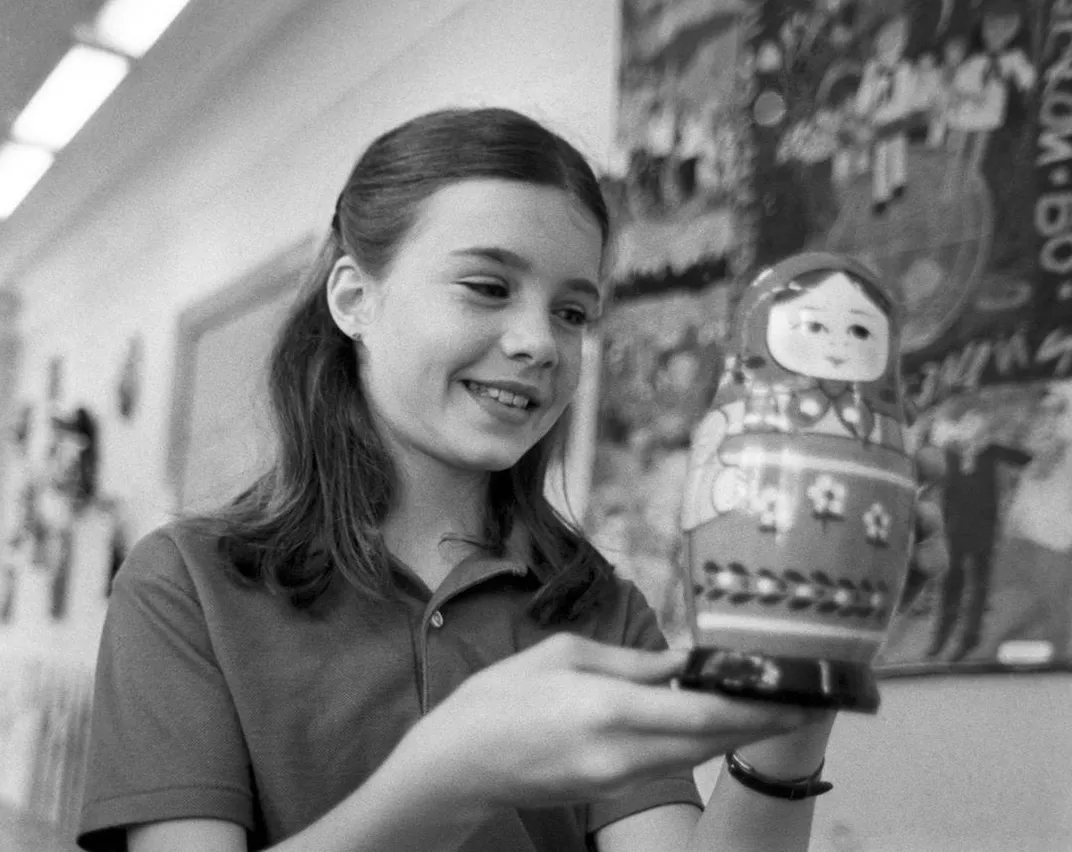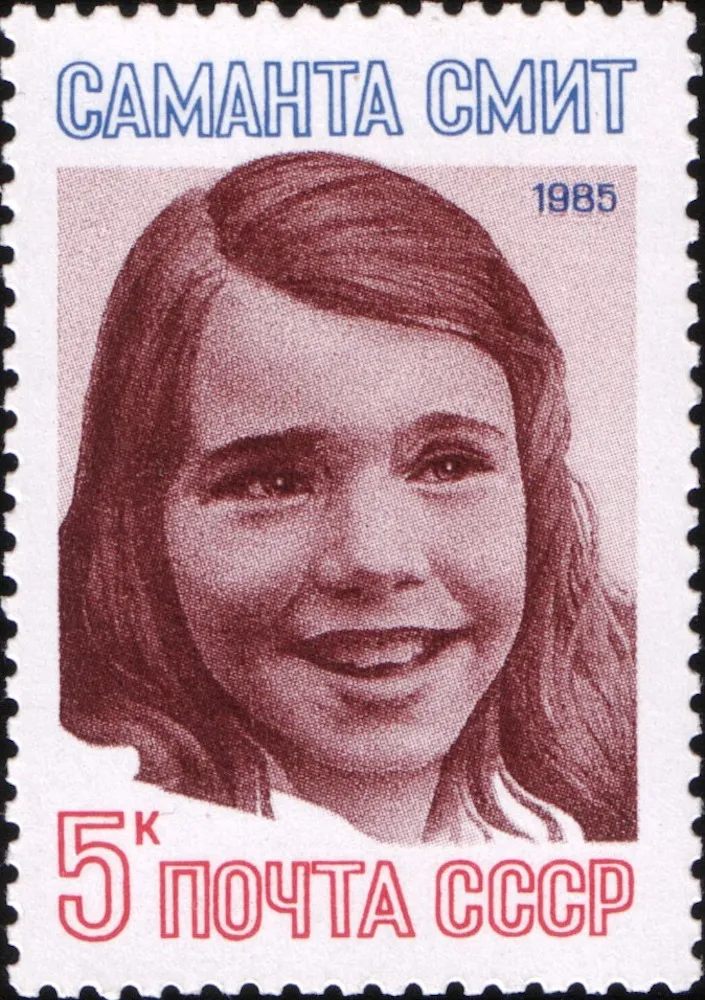The Surprising Story of the American Girl Who Broke Through the Iron Curtain
Samantha Smith was only 10 when she wrote to Soviet General Secretary Yuri Andropov about the Cold War. In response, he invited her for a visit
/https://tf-cmsv2-smithsonianmag-media.s3.amazonaws.com/filer/82/b3/82b3643a-689e-43aa-9f85-45bf46aea497/1024px-rian_archive_793152_us_girl_samantha_smith_in_artek-wr.jpg)
Even at age 10, Samantha Smith already knew important things about the world. She’d studied World War II and the dropping of atomic bombs on Japan. She listened to newscasters speak in dire terms about missiles and the Cold War, and she watched a science program about what would happen to Earth’s ecosystems if nuclear war broke out. One morning the Maine schoolgirl woke up wondering if this very day might be the last one for all of humanity.
After Samantha confessed her fears to her mother, Jane Smith brought out the November 22, 1982 issue of Time magazine that featured Soviet General Secretary Yuri Andropov on its cover. The new Russian leader had just taken power, and Jane suggested her daughter write him a letter. Samantha did so, asking bluntly, “Are you going to vote to have a war or not? … I would like to know why you want to conquer the world or at least our country.” The letter was posted in December 1982, and Samantha continued the normal course of her life.
Until the Soviet newspaper Pravda (the official paper of the Communist Party) published excerpts of the letter several months later, with comments from Andropov himself.
Upon learning that her writing had appeared in the paper, Samantha wrote a second letter, this time to Soviet ambassador to the United States Anatoly Dobrynin, wanting to know why Andropov hadn’t responded directly to her. On April 26, 1983, the Soviet leader did so—and invited Samantha and her family to visit the U.S.S.R. “You will find out about our country, meet with your contemporaries… and see for yourself: in the Soviet Union, everyone is for peace and friendship among peoples,” Andropov wrote in Russian, accompanied by an English translation.
So began the unlikely adventures of Samantha Smith, dubbed “America’s Youngest Ambassador” by the press, as she took up Andropov’s offer and visited in July of 1983. While her visit to the Soviet Union had little impact on the policy decisions of Andropov and President Ronald Reagan, nor did it turn the course of the Cold War, it offered proof to citizens of both nations that the other was, in fact, human.

1983 was a perilous moment in the Cold War—just that March, Reagan delivered his “Evil Empire” speech, calling for increased military spending and a modernized nuclear stockpile to thwart the Soviet Union. Meanwhile, in the Soviet Union, Andropov compared Reagan to Adolf Hitler.
But it wasn’t only heated rhetoric causing heightened fears; the respective militaries also seemed to dance on the line between détente and war. While Americans worried about SS-20 missiles pointed at them, the Russians feared Pershing II missiles that could “fly 1,000 miles in six to eight minutes, and land with high accuracy and virtually no warning,” according to the Washington Post. As Soviet leader Mikhail Gorbachev would later say, “Never, perhaps, in the postwar decades was the situation in the world as explosive and hence, more difficult and unfavorable, as in the first half of the 1980s.”
With her parents and a press entourage to rival any celebrity, Samantha waded into the thicket of Cold War politics. Over the course of two weeks, she visited Lenin’s grave and the Bolshoi Ballet; made friends at the Artek summer camp in Crimea and met Valentina Tereshkova, the first woman to go to space. Soviet and Western press followed her every footstep, documenting all the encounters and the girl’s reaction. “Some people have the wrong impression about the Soviets,” Samantha told the reporters. “[They] want peace like I do.”
It was a message that resonated with people from both countries. Writer, teacher and historian Lena Nelson, who is currently at work on a book about Samantha, grew up in the Soviet Union and vividly remembers the young girl who visited her country. “For my generation of the Soviet children growing up in the early 1980s, the word ‘American’ meant only one thing—an enemy, similar to that of the Nazi Germany during WWII,” Nelson said by email. “Seeing Samantha and her parents on my TV that summer and realizing that they looked and acted ‘just like us’ was an eye-opening experience. It was hard to think of Americans as enemies.”
The media fascination with Samantha’s story only increased after the Smiths returned home. She appeared on “The Tonight Show with Johnny Carson,” interviewed Democratic presidential candidates for the brand-new Disney Channel, and began writing her own book. In interviews, Samantha described the Russian kids being just the same as those she knew in the United States, and said, “They were just really nice people to me.” The incident was even parodied on an episode of the sitcom “The Golden Girls,” when Rose pens a letter to Gorbachev and is mistaken for a child.
But with the intense coverage came questions about whether Samantha had been used as a pawn by both governments to distract from the real problems. Reporters at United Press International pointed out that the Smiths had brought with them on their trip hundreds of letters from Russian emigres living in the United States hoping to acquire exit visas for their relatives, but none were issued. And a letter to Andropov from a Soviet girl named Irina Tarnopolsky made the rounds in the American press, describing how the girl’s Jewish family hoped to emigrate to Israel, but her father had been arrested for anti-Soviet agitation. Unlike Samantha, Irina never received a response and her father was sent to a Siberian work camp. (It was later discovered Irina signed the letter, but didn’t write it; eventually the Tarnopolsky family was able to leave Russia.)
Nelson argues that in speaking for herself as a regular, American girl, Samantha had an impact that superseded general mistrust of the governments’ intentions. “While it is possible that the Soviets’ goal was to use her to project an image of a peace-loving nation, Samantha and her parents’ trip also placed the Americans in a favorable light, thus making it harder for the Soviets to continue with their depictions of Americans as evil warmongers,” Nelson said.

In the months after Samantha’s tour as “Goodwill Ambassador,” Soviet and American relations continued to deteriorate. The world nearly fell into nuclear war during a November training exercise by NATO and American forces called “Able Archer.”
“The leaders of the superpowers hadn’t met in years and dialogue had broken down on a number of tracks,” says Marc Ambinder, a professor of journalism at the University of Southern California and author of the forthcoming book The Brink: President Reagan and the Nuclear War Scare of 1983. “I don’t think [Samantha’s trip] had much of an effect, but it did reflect the cross-current of Americans generally being skeptical of a nuclear buildup.”
As the Cold War continued to simmer, Samantha seemed prepared to stay in the public eye as a token of what could be achieved by curiosity and openness. But in August 1985, Samantha and her father were killed in a plane crash on their way home to Maine. The following year, Samantha’s mother, Jane, returned to the Soviet Union with 20 of Samantha’s classmates and visited some of the numerous memorials for her daughter. For years, Jane also spearheaded a foundation that promoted cultural exchanges between students in the U.S.S.R. and the United States.
Although Samantha’s journey may not have altered the war, Ambinder does believe that cultural exchanges have an impact on how nations see each other. “They’re often ordinary people or academics or doctors and professionals who are providing much more granular descriptions of what everyday life is like,” Ambinder says.
And for a few years, that window into ordinary American life was offered by Samantha and her family.
/https://tf-cmsv2-smithsonianmag-media.s3.amazonaws.com/accounts/headshot/lorraine.png)


/https://tf-cmsv2-smithsonianmag-media.s3.amazonaws.com/accounts/headshot/lorraine.png)